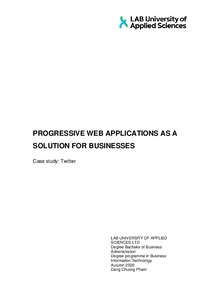Progressive web applications as a solution for businesses : Case study: Twitter
Pham, Dang Chuong (2020)
Lataukset:
Pham, Dang Chuong
2020
Julkaisun pysyvä osoite on
https://urn.fi/URN:NBN:fi:amk-2020120826847
https://urn.fi/URN:NBN:fi:amk-2020120826847
Tiivistelmä
Progressive web applications (PWA) are web applications with features such as accessing the camera, working while staying offline, navigation, like those of a native mobile application. This type of application makes use of the Web platform and aims to create an app-like experience while keeping the Web's low friction advantages. Inheriting the good of both worlds, PWAs can be a promising solution for businesses interested in expanding their customer reach to more than just users of the app stores.
This study attempts to explore the PWA, its current capabilities, and how it can be useful for businesses. The study also investigates end-users’ attitudes towards this new type of application compared to the native mobile application in the social media context and focuses on end-users’ preferences before and after knowing the differences between the two applications. The goal is to provide a starting point for businesses interested in serving their customers using PWAs.
The study follows the inductive approach, the qualitative strategy, and the case study research design. Twitter is chosen as the case. The study uses both primary data and secondary data. Secondary data is used to establish a general knowledge of PWAs and their current capabilities. The primary data is collected by conducting usability tests and interviews with end-users.
The study shows that most users choose the PWA for its design. Most users also feel that the native mobile application is smoother than the PWA. Importantly the main reason for switching from a PWA to a native mobile application is the lack of features, such as push notifications, filters, and editing tools for taking photos. These findings emphasize the importance of user interface design when a user chooses between these two applications. Based on the findings, several suggestions are given for businesses that are interested in the PWA.
This study attempts to explore the PWA, its current capabilities, and how it can be useful for businesses. The study also investigates end-users’ attitudes towards this new type of application compared to the native mobile application in the social media context and focuses on end-users’ preferences before and after knowing the differences between the two applications. The goal is to provide a starting point for businesses interested in serving their customers using PWAs.
The study follows the inductive approach, the qualitative strategy, and the case study research design. Twitter is chosen as the case. The study uses both primary data and secondary data. Secondary data is used to establish a general knowledge of PWAs and their current capabilities. The primary data is collected by conducting usability tests and interviews with end-users.
The study shows that most users choose the PWA for its design. Most users also feel that the native mobile application is smoother than the PWA. Importantly the main reason for switching from a PWA to a native mobile application is the lack of features, such as push notifications, filters, and editing tools for taking photos. These findings emphasize the importance of user interface design when a user chooses between these two applications. Based on the findings, several suggestions are given for businesses that are interested in the PWA.
